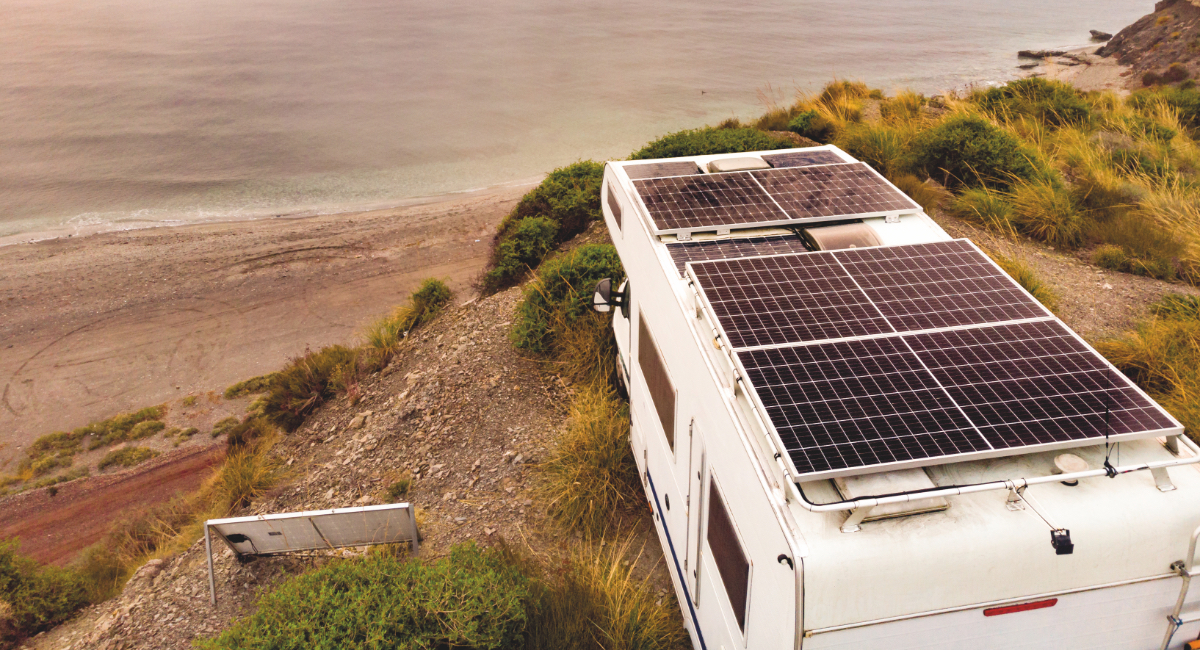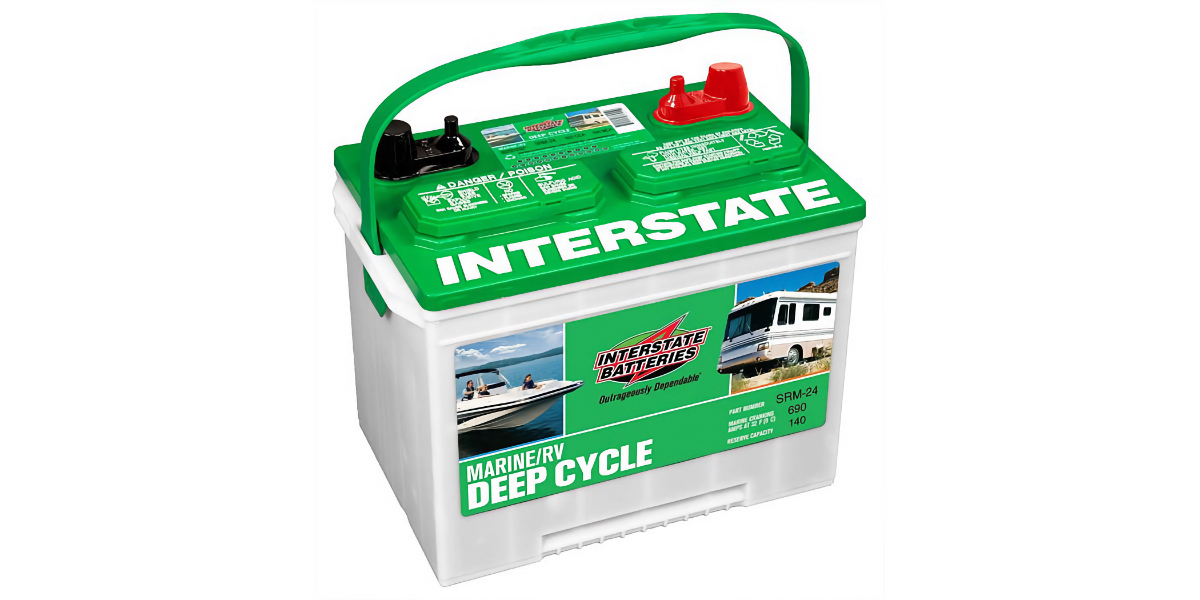Advice and tech Q&A from our RV and overlanding expert to help you sort out your issues. Here are a few answers submitted by our readers. Have a question for us? Send it to knowhow@wildsam.com.

Yellow spring flowers and camper vehicle wild camping in the distance. Caravan vacation in Spain.
Seasonal Maintenance: Springing Into Action
It’s been a long winter, and for many RVers, warm-weather adventures and the road beckon. Not so fast, though! After months of inactivity, wind, rain and sun can take a toll on your vehicle. A bit of seasonal preparation can prevent major highway problems.
A top-down approach is logical. Climb up on the roof and thoroughly inspect the roof material and any sealers that prevent water from seeping in around vents, air conditioners, solar panel mounts, etc. Over time, these deteriorate, which can lead to serious interior damage if neglected. If you find any cracks or deteriorated sealants, carefully scrape away the old material and replace it with new products such as lap sealant. A heat gun or even a blow dryer can be used to soften up stubborn baked-on material. Inspect the sidewalls and slide-out rooms and lubricate the sliding seals. Local RV shops can step in on any of these tasks if you’re not feeling confident.
Clean your rig inside and out. Check all the cubbies and compartments for moisture incursion and rodent damage. De-winterize the water system: add freshwater, fill the water heater, test the pump and flush through all the lines by running the sinks, toilets and showers. Add toilet chemicals. Operate all appliances, extend the awning and then lock it in place for travel. Don’t forget to inspect fire extinguishers and propane, carbon monoxide and smoke detectors.
Batteries are all-important. Wet-cell batteries should have their water levels checked and get topped off with distilled water. Inspect and clean the terminals. Many local auto-parts stores will test batteries for free. (A fully charged lead-acid 12-volt battery should read 12.65 volts and have a specific gravity of 1265.) Complete the job by testing all the lights and electrical accessories on the RV.
Tires need love too! Give them a good overall inspection, looking for uneven wear, tread depth, cuts, curb and pothole damage. Older tires may have sidewall cracking from age and weathering. The best way to inspect trailer tires is to remove them, so you can see the back sides and check the wheels for damage, cracks and corrosion, etc. Trailer wheel-bearing inspection, repacking, seal replacement, brake inspection and adjustment should all be done on a regular basis in conjunction with tire inspection. Once a year is a good cadence, and getting that moment out of the way before you hit the road for peak travel season makes a lot of sense.
Of course, tire and wheel removal is not so easily done on a motorhome. If you suspect problems, consider taking your rig to a tire shop. Motorhomes will require another set of maintenance items, including engine oil changes, fluid checks and flushes (depending on how long since the last ones) and generator maintenance (check owner’s manuals for schedules). Check tire date codes. They are stamped on the sidewall after the marking “DOT.” The last four digits are the manufacturing date. The first two of those digits indicate the week, and the last two digits indicate the year. For example 1118 would indicate the 11th week of 2018. Most manufacturers recommend replacing tires more than six years old.
Inflate the tires to the recommended pressure, including the spare. Read the recommendations on the sidewall, and never exceed maximum rated pressure.
Got a question for columnist Ken Freund? Write knowhow@wildsam.com.
Photo Credit: Getty
Let’s Talk Tire Pressure
Q: I recently read, in “The Rally” section of the February/March issue of Wildsam, the exchange regarding tire pressure and monitoring systems. The author noted keeping the tire pressure at 60 psi cold for his Goodyears. I just wanted to point out that if he has a dual-axle trailer, and the tires are Goodyear Endurance brand, the inflation pressure could be significantly less than 60 psi. Based on Goodyear’s published specs for the Endurances, depending on weight carried per tire, pressure should be in the 40 to 45 range. Over-inflation can lead to failure.
As an example, our 30-foot Airstream weighs in at 7,600 pounds ready for travel, or 1,900 pounds per tire. We have run 47 psi in our Goodyear Endurance tires for several years, now on our 2nd set. (The first set aged out.) Inflation pressure is a frequently debated issue. What’s your take on it for the situation described by the author?
—Phil Abele
A: Thanks for writing! Our previous correspondent didn’t include the size and model of his tires, so I didn’t address that in my reply. According to the load-inflation chart for the Endurance tires, every single 14-inch tire has a weight rating in the 65 psi column. That means that all of these tires are designed to withstand at least that much inflation pressure.
Tires that are overinflated for their actual load, but are within their maximum rated inflation pressure, are likely to wear near the center of their treads, provide an unnecessarily harsh ride and bruise more easily from hitting sharp edges in the road surface. However, they likely will run cooler than at lower-inflation pressures for a given load, and they shouldn’t be at a significantly higher risk of blowouts than a similar tire inflated to the correct pressure.
Photo Credit: MDC USA
Towable Twofer
Q: I recently acquired a full-size pickup truck and a large RV trailer with a conventional hitch, and I have a couple questions. Where can I get driving instruction and practice? And then, regarding adding a friction-type anti-sway bar to the hitch assembly: Do I need to have that professionally installed, or should a good DIYer be able to do it?
—Cynthia Boccio, Currie, NC
A: I’m glad to hear that you are interested in safety training. Depending on the level of your driving experience, there are several options. There are online classes, instructors who will travel to you and classes at fixed locations around the country. You might check out rvschool.com or rvbasictraining.com. You might also ask a local driving school or campground host if they know of a local RVer who offers instruction.
It’s also good to add a sway control. Fishtailing can occur quickly and build up to a dangerous uncontrollable jackknife situation in seconds. Camco, Curt and Reese are some of the companies that offer the popular friction-type controls. They generally mount using a threaded ball stud at one end and a metal plate with a ball attached, which gets bolted in place. The stud requires a larger drill bit, but most DIYers should be able to do it if they can drill holes and follow instructions well (as this is a safety item).
Photo Credit: Forest River
A Stable Destination
Q: We purchased a 42-foot destination trailer, which we will be keeping permanently on a lake lot. I have seen most of these trailers leveled and stabilized with concrete masonry units under the frame on all four corners or even in six locations. Is this the correct method for permanently stabilizing this type of trailer? Do I need to be worried about doors being out of square doing this? Is there a better way?
—Troy Corbett
A: For folks unfamiliar with the term “destination trailer,” this is a class that fits somewhere between travel trailers and park models. They are typically larger (102″ wide) and taller (11’4″ to 11’11”) than travel trailers, and most are at least 38 feet long. Some of their features make regular towing and camping impractical, such as glass patio doors and house-type appliances that don’t work well for anything but being on a permanent or semi-permanent site.
Now, to the question. The more supporting points under the frame, the more level and secure the trailer will be. The fewer support points, the more frame flex you will have. I recommend more than six points for such a large trailer. Soil conditions and frame design will determine how many piers or blocks need to be used. I suggest that you find a local company that specializes in moving and situating mobile and manufactured homes in your area. You can also inquire at local mobile home parks for mover and installer references and referrals.
Photo Credit: Getty
MPH vs. KPH
Q: We think we have a stumper for you! We have a 2007 Monaco Cayman XL motorhome that we bought last year and have gone on a few trips with it. On one of our trips, we noticed that our odometer was set for kilometers, not miles. We have tried everything we could find as a suggested fix: We’ve pressed and held the trip set, we’ve pressed it twice, etc. We tried when the vehicle was running and when it was not running. Any ideas?
—Lynn Mondello
A: Your motorhome’s owner’s manual says “the trip reset button located below and to the right of the speedometer is used to switch between the odometer, two trip meters and the transmission temperature. Select trip meter 1 or 2 and hold the trip button down for 3 seconds to reset.” However, it does not specify how to toggle between metric and Imperial measurements. This is an important function, because the coaches are sold in both the USA and Canada. I would try going to the main odometer, then hold it for at least three seconds. If necessary, try it both with the engine off but key on, and with the engine running. If all else fails, call customer service!
Ask Us Anything!
Share your tech tales and send us your questions to knowhow@wildsam.com. Perhaps our RV expert can help you solve your problems.
This article originally appeared in Wildsam magazine. For more Wildsam content, sign up for our newsletter.
The post Ask an RV Expert: Seasonal Maintenance, Tire Talk, and Where to Learn to Drive an RV! appeared first on RV.com.

